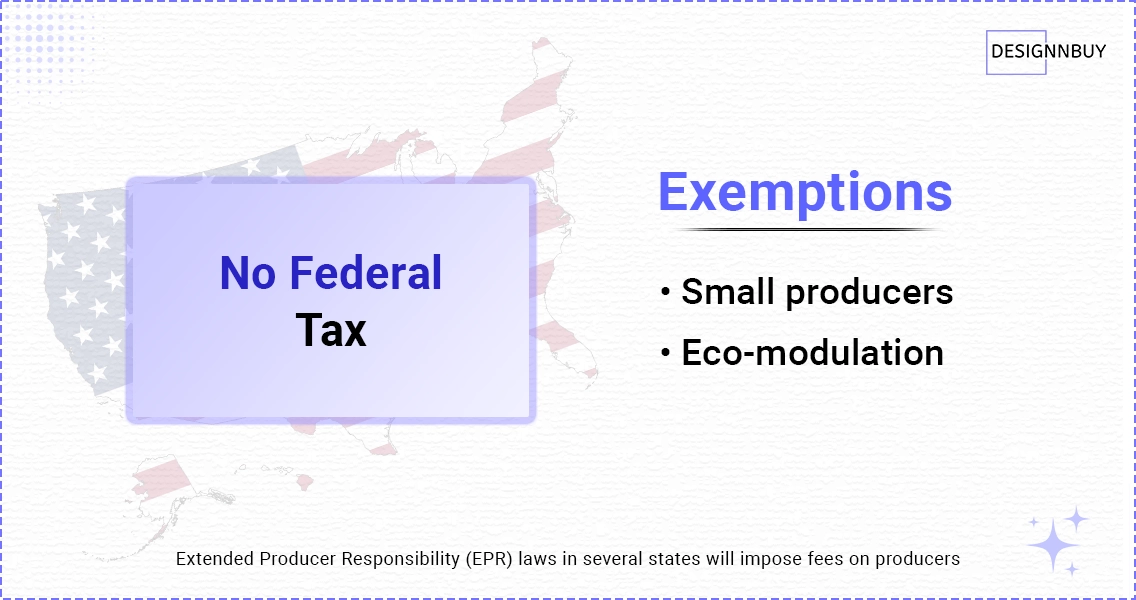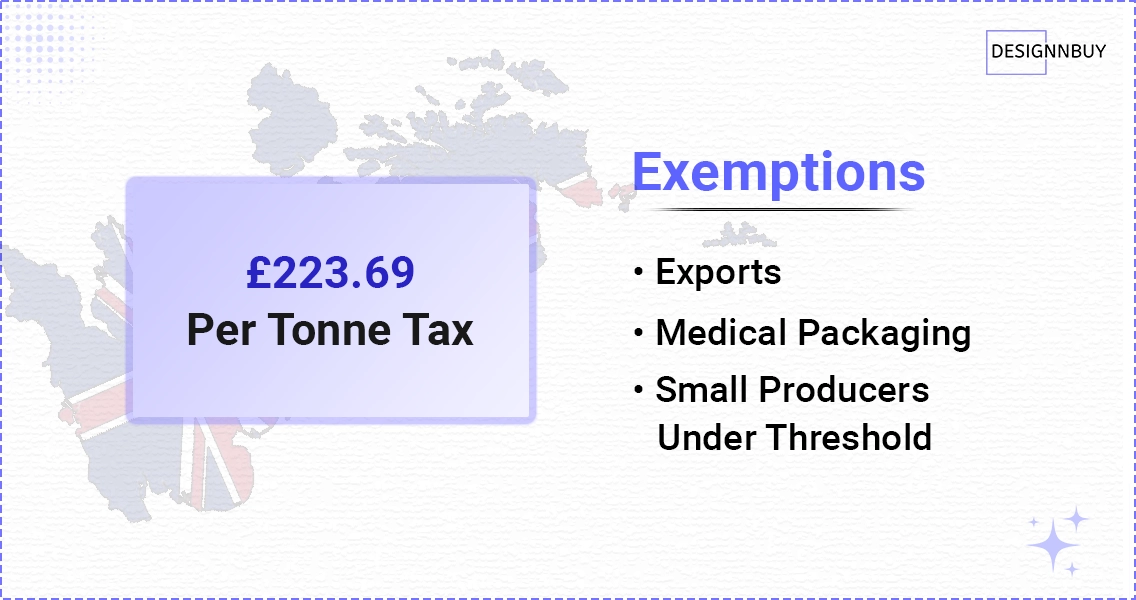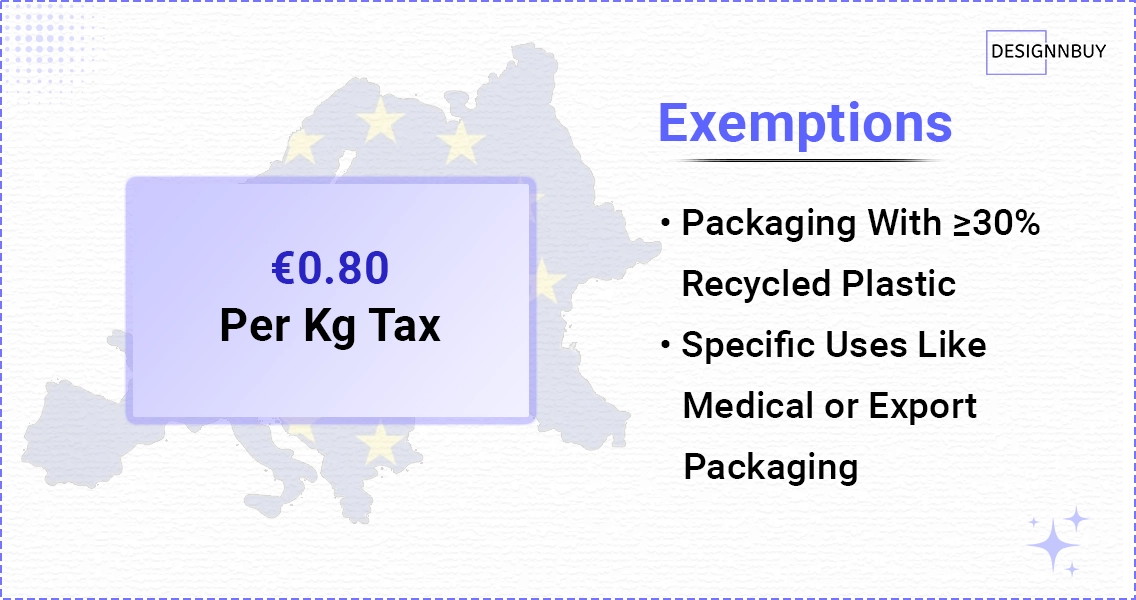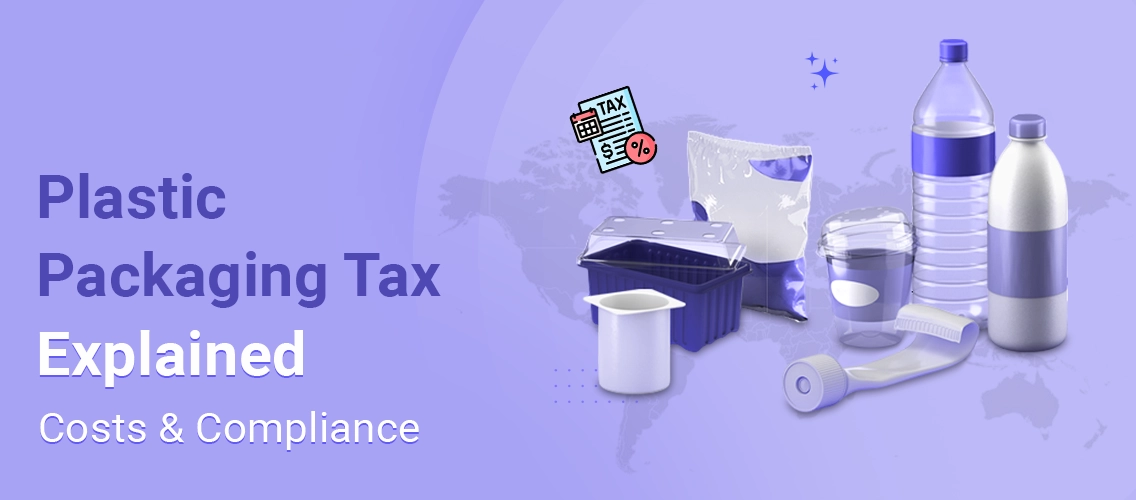Plastic packaging waste is one of the biggest environmental concerns of our time. Therefore, governments worldwide are trying hard to reduce their impact by adding regulations. From the UK’s Plastic Packaging Tax to the EU’s levy on non-recycled plastics, companies face new costs, compliance requirements, and sustainability pressures.
For businesses, these measures aren’t just about environmental responsibility; they directly affect profit margins, supply chains, and brand perception.
If you are offering plastic packaging, you need to understand what these taxes mean, how much they will cost you, and what solutions can help you stay competitive.
In this guide, we break down the Plastic Packaging Tax in the US, UK, Europe, and APAC countries, global policies, who needs to pay the tax, and exemptions.
Table of Contents
United States - State-Level EPR for Print Packaging Providers

There’s no federal plastic packaging tax in the U.S. but starting in 2025, Extended Producer Responsibility (EPR) laws in several states will impose fees on producers to fund packaging recovery and recycling.
As a print packaging provider, particularly if you’re offering custom boxes, labels, or flexible packaging in these states, these laws can directly affect your costs and compliance.
Latest Status & Deadlines (2025)
- Active EPR States (as of mid-2025): Maine, Oregon, California, Colorado, Minnesota, Maryland, and Washington have passed EPR laws for packaging.
- Reporting & registration deadlines vary by state:
- Oregon: Program begins July 1, 2025, with reporting of 2024 packaging due by March 31, 2025.
- Minnesota: Producers must register by July 1, 2025.
- Colorado: Draft plan by February 2025; data reporting by July 31, 2025; compliance begins in early 2026.
- California: No fees until January 1, 2027, but reporting and planning start earlier.
- Maryland & Washington: EPR laws signed in May 2025; producers must join a PRO by July 1, 2026.
Who Pays the Plastic Packaging tax in the U.S?
- “Producers” typically include custom packaging providers, brand owners, importers, or distributors. If you design, produce, or import personalized print packaging sold to customers in any of these states, you are likely considered a producer under the law.
- Even if your business only prints or finishes already-produced packaging, you could still have obligations depending on your role in the supply chain.
Exemptions
- Most laws include small-producer exemptions, often based on volume or revenue thresholds, though specifics vary by state.
- Eco-modulation incentives mean packaging that’s recyclable or contains recycled content may qualify for reduced fees.
- States may exclude certain B2B or industrial packaging categories—but customized consumer packaging (e.g., branded mailers, sleeves, retail packaging) is typically covered.
▶️ Take your packaging business online with Web-to-Pack. Book a demo today.
UK: Plastic Packaging Tax for Custom Print Packaging Printing Business

For print packaging providers, the plastic packaging tax in the UK means that any custom-printed plastic packaging, whether empty or filled, can be subject to this environmental levy.
It applies to items like bespoke sleeves, labels, bags, trays, and caps if they’re predominantly plastic by weight and contain less than 30% recycled content. This tax is a nudge to move toward recycled materials and reduce waste.
Latest Rate (2025)
From 1 April 2025, the plastic packaging tax in the UK is set at £223.69 per tonne for packaging with under 30% recycled plastic.
Who Pays the Tax?
- You must register and pay the tax if your custom print packaging business manufactures or imports 10 tonnes or more per year into the UK—this includes filled bespoke packaging.
- Even if you only perform final finishing, like applying labels or coatings, that counts as a “substantial modification,” potentially placing liability on your operations.
Exemptions
Your print packaging may be exempt if it meets any of the following:
- Contains ≥30% recycled plastic by weight, which will fully exempt you from the tax.
- Used for licensed human medicines, immediate medical packaging is exempt.
- Used as transport packaging for importing goods (e.g., pallet wrap), this type of packaging is excluded.
- Packaging exported outside the UK may qualify for relief, unless still used domestically as transport packaging.
- If you handle under 10 tonnes annually, you must still register, but likely won’t pay the tax, and retain records verifying your position
EU Region – Plastic Packaging Tax for Custom Print Packaging Businesses

The plastic packaging tax in the EU currently functions as an EU-level levy, not a direct tax on businesses.
Since 2021, each EU Member State pays €0.80 per kilogram of non-recycled plastic packaging waste collected at the national level. This is designed to incentivize increased recycling and stimulate greater uptake of circular packaging solutions.
By 2028, the EU plastics levy, part of the bloc’s “own resources”- is planned to rise to €1 per kg, reflecting inflation and increasing recycling ambitions.
However, some countries (like Germany) are considering national-level plastic packaging taxes to recover their contribution directly from businesses.
Meanwhile, many Member States are implementing Extended Producer Responsibility (EPR) schemes or packaging fees to pass the cost downstream.
Latest Rate (2025)
EU-wide levy: €0.80 per kg of non-recycled plastic packaging waste.
Expected rate from 2028: €1 per kg, adjusted annually for inflation.
Who Pays the Tax?
The direct plastic packaging tax in the EU is not levied on businesses—Member States pay it from national budgets. However, many governments pass this cost onto packaging producers via national taxes or EPR schemes.
For personalized print packaging businesses:
- If you supply custom plastic packaging to EU countries, these national mechanisms may apply.
- You may be required to register as a producer, submit packaging tonnage metrics, and pay eco-fees under national EPR frameworks—but this depends on each country’s implementation.
Exemptions
Exemptions are national-specific since the levy is EU-collected:
- Some countries exempt high-recycled-content packaging or reusable formats under EPR schemes.
- Small businesses may be exempt based on volume or revenue thresholds, varies by country.
- Packaging destined for export markets may be exempt depending on national rules.
For instance, Germany may delay introducing a national plastic tax until 2026 and is still defining exemptions.
Asia-Pacific (APAC): What Customized Print Packaging Providers Should Know
Unlike the EU or the UK, the APAC region doesn’t have one unified plastic packaging tax. Instead, each country sets its own rules, often through Extended Producer Responsibility (EPR) laws, recycled-content targets, or outright bans on certain plastics.
For businesses offering customized or personalized packaging, like branded shipping boxes, custom-printed bags, or food packaging, these regulations directly affect material choices, design flexibility, and overall costs.
The key message? If you’re serving customers in APAC, your packaging designs need to be recyclable, reusable, or compostable, and in many countries, they must include a minimum percentage of recycled plastic.
Southeast Asia (Philippines, Vietnam, Indonesia, Singapore)
Latest Rate (2025):
- Philippines: Businesses must recover up to 80% of their plastic packaging by 2027.
- Vietnam: Producers contribute to the Environmental Protection Fund and follow recyclability standards.
- Indonesia: On a roadmap toward 50% recycled content and 100% recyclable packaging by 2029.
- Singapore: From March 2025, companies must report packaging volumes; bottle deposit-refund systems launch in July 2025.
Who Pays the Tax?
- Businesses that produce or import packaging, including personalized mailers, boxes, or branded bags, must register and report packaging use.
Exemptions
- Some countries exempt small producers or low-volume exporters, but this varies by law.
What does it mean for you?
- If you ship custom packaging into Southeast Asia, build reporting and recyclability into your process. Working with local compliance partners or PROs is often the easiest way forward.
Australia & New Zealand
Latest Rate (2025):
- 100% of packaging must be reusable, recyclable, or compostable.
- Plastic packaging must include at least 20% recycled content, moving toward 50%.
- Overall recovery target: 70% of plastic packaging.
Who Pays the Tax?
- All packaging suppliers, including those offering custom-branded packaging.
Exemptions
- None officially in place as of 2025.
What It Means for You
- If your designs use non-recyclable plastics, you risk being locked out of the market or facing reputational damage. Clients in Australia and New Zealand will increasingly demand sustainable options.
Japan & South Korea
Latest Rate (2025):
- Japan: The Plastic Resource Circulation Law requires traceability, labeling, and registration for all packaging (including imported, custom-printed items). Compostable packaging must be officially certified.
- South Korea: Long-standing EPR rules already cover packaging, with strict recycling and tracking systems.
Who Pays the Tax?
- Businesses importing or producing packaging, including custom-branded trays, sushi boxes, or bags, must comply.
Exemptions:
- Very limited; most packaging providers must meet the standards.
What does it mean for you?
- Japan and Korea leave little room for error. If you’re offering custom packaging here, you’ll need to prove recyclability, provide proper labeling, and work only with approved materials.
India
Latest Rate (2025):
- By April 1, 2025, all food-contact plastic packaging (like bottles and pouches) must contain at least 30% recycled plastic.
Who Pays the Tax?
- The responsibility lies with brand owners, packaging manufacturers, and importers, so if you’re offering custom pouches or bags, you must ensure the raw materials meet the recycled content requirement.
Exemptions
- The Central Pollution Control Board may allow short-term exemptions for technical reasons, but non-compliance is tracked and can’t be avoided long-term.
What does it mean for you?
- If your clients demand personalized packaging in India, start sourcing recycled materials now. Falling short could delay orders or increase costs.
Conclusion
Rules on plastic packaging are tightening everywhere. The plastic packaging tax in the UK, the evolving plastic packaging tax in the EU, new U.S. state EPR laws, and APAC’s recycled-content mandates all show the same trend: recycled content is no longer optional.
For print and packaging businesses offering customization and product personalization, this shift is more than a compliance burden. It’s a chance to differentiate your services.
When you design with recyclability in mind, use recycled materials, and keep your compliance records in order, you don’t just avoid fines, you position yourself as a trusted, future-ready packaging partner.
If you’re looking to streamline your operations, offer eco-friendly packaging options, and stay ahead of changing laws, DesignNBuy gives you the tools to do it all.
Want to Offer Personalization at Scale?
Our Web-to-Pack solution helps you deliver custom packaging with ease.
Related Blogs:
- What Is High-End Luxury Packaging? 2025 Guide for Print and Packaging Businesses
- 7 Biggest Challenges of the Packaging Industry and How Web to Pack Solves Them
- DesignO 2.4 Makes Selling Custom Packaging Easier Directly From the Product Detail Page
- 7 Best Packaging Design Software for Online Print Shops in 2025

